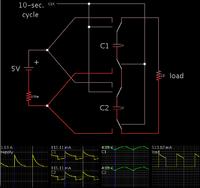Sujith Zis
Newbie level 3

I needed to make a supercap battery bank circuit with >>5V input connected to, two 5.4V supercapacitors connected in series , and output from supercapacitors with on/off switch.<< Its harder the way I did it
also will i be able to get 10V Vout after fully charging the supercapacitors
also will i be able to get 10V Vout after fully charging the supercapacitors




